
I just read the new Jack Reacher book Blue Moon, though naturally the title isn’t necessary, nor does it really relate to the book in any way except for a random line of dialogue. Jack Reacher stories I’ve read before, though not for a while. I stopped for a few reasons. Go look at goodreads and you’ll find the usual criticisms. Formulaic. Unrealistic. And for this one, the murderous vigilante turn of JR himself. Sounds like a good summer read to me, but safe to say Lee Child is not regarded as high art. But this is a craft analysis, not a review, not a critique. These books work for a reason. And as a teacher of mine used to say, if you don’t understand what works, you’ll never get why things do well. Let’s look at one really critical thing about Lee Child’s craft, which is how he does action/fight scenes.

At most writers conferences (even the romance ones) I see a session on the program about writing fight scenes. Sometimes there’s talk about short sentences, which is either good advice (because short sentences create a sense of urgency and rapid change) or bad advice (because so many full stops actually slows down reading and makes it seem slower, not faster). This contradiction is a natural part of what’s known as practitioner’s lore (North), and every writer is familiar with it. Every craft principle has a contradiction, an exception. I wrote paragraphs in my PhD on it. I won’t here.
Lee certainly uses the short sentence rule. Often the short sentence fragment rule.
Abby’s phone rang. She answered. Vantresca. She put him on speaker. She walked with her phone out in front of her, carried flat on her hand.
Blue Moon, p. 246
They couldn’t stand on the corner like they were hailing a taxi. Not if exposure was their main concern. Reacher looked all around. Unpromising.
Blue Moon, p. 247
The short sentences are p-p-p-pow. It’s a little frenetic, certainly noticeable. But it’s not what I want to pull out of what Child does. It’s what the action/fight scenes actually contain, which is pretty little in terms of actual blow trading. Most of it is thinking: information and processing. Reacher’s observations. Reacher’s rationale about what is happening. His predictions.
They retraced their steps. Two turns. Back to the steel hatch. Abby held her phone close to a hinge. It looked like a quality item. Forged steel. A glassy surface. But no trace of grease or oil. Unpredictable. The hatch had no handle. Not as such. Just two thick hoops for the bolt to lock into. Reacher hooked his finger through one of them. In his mind, he rehearsed what he would do next, either fast or slow. The hatch would be hidden on the inside by some kind of camouflage. Nothing too fancy. Nothing that would have involved visible workers. Nothing …
Blue Moon, p. 337
You get the idea. The actual action takes about half the space of the preparation for action in this sequence. And the action itself is often foregone: Reacher will prevail. This goes against a lot of conventional wisdom for how to develop tension in a story. To actually put the protagonist in danger, or at least, the people they care about. That isn’t really what happens in this novel. I don’t remember that happening in a couple of earlier Reachers I read either.
I think that it works because the pleasure of Jack Reacher is in watching him machinate through his tactics like greased code. We are treated to seeing what a clever and skilled man he is (while simultaneously professing to be so very of the people), and so most of the action/fight scenes are deeply rooted in him working it out. It’s the police procedural of action. Seeing him hypothesise creates anticipation, which is perhaps the most critical thing that a story must do. And anticipation can’t just be about not knowing what will happen – it’s far more specific than that. We must have some idea of the likelihood and consequences. And that’s what this does (and not to devalue Lee’s writing here – you need the rest of the story to build the world that contextualises those consequences).
Anyhoo, in this context of lots of thinking, the short rapid fire sentences seem to function in both the apparently mutually exclusive ways: they slow the action enough to have thoughts, while keeping those thoughts compressed. That’s what you call a paradox, kids. But holding paradoxes in our heads is what makes us human. Nicely played, Mr Child.
In the few cases where you do get paragraphs of blow by blow action, they’re pretty boring tbh. Which might be why we don’t get many.
So, learning from the Lee Child school of craft? Action is about anticipation, and that’s far more about what’s doing between the ears than what’s doing with the hands and feet.